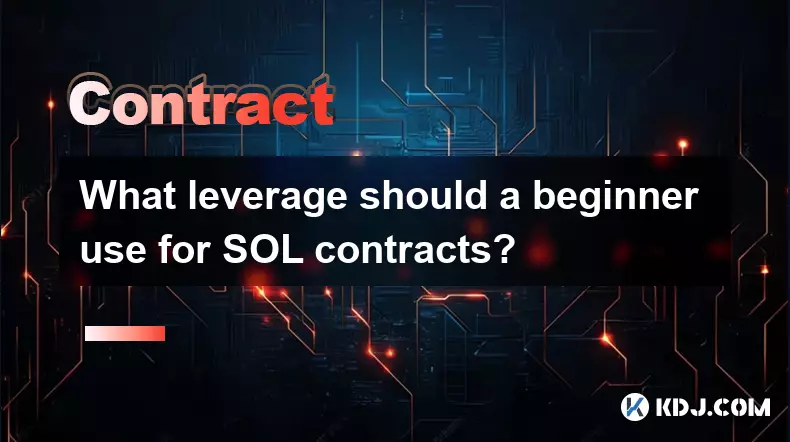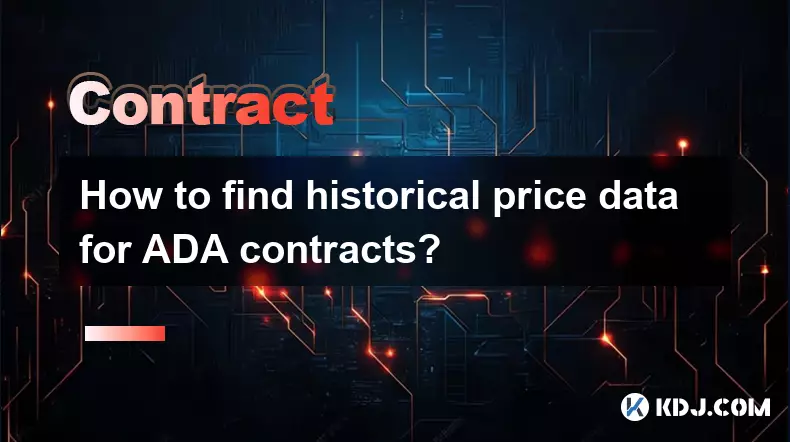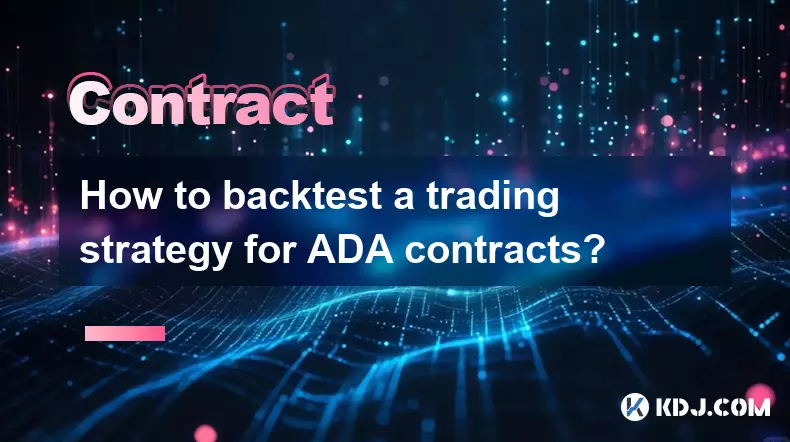-
 bitcoin
bitcoin $108309.944805 USD
-1.81% -
 ethereum
ethereum $3861.653445 USD
-2.57% -
 tether
tether $1.000476 USD
0.02% -
 bnb
bnb $1064.809647 USD
-3.07% -
 xrp
xrp $2.422923 USD
-2.29% -
 solana
solana $186.552328 USD
-0.93% -
 usd-coin
usd-coin $0.999917 USD
0.00% -
 tron
tron $0.322438 USD
-0.01% -
 dogecoin
dogecoin $0.194315 USD
-2.57% -
 cardano
cardano $0.642133 USD
-3.06% -
 chainlink
chainlink $17.657259 USD
-6.17% -
 hyperliquid
hyperliquid $35.120261 USD
-7.45% -
 ethena-usde
ethena-usde $0.999614 USD
0.03% -
 stellar
stellar $0.312748 USD
-3.27% -
 bitcoin-cash
bitcoin-cash $480.377391 USD
0.23%
What leverage should a beginner use for SOL contracts?
New traders should use 2x–5x leverage on SOL contracts to reduce liquidation risk, preserve capital, and build disciplined trading habits in volatile markets.
Oct 20, 2025 at 09:00 am

Understanding Leverage in SOL Contracts
1. Leverage allows traders to control a larger position using a smaller amount of capital. In the context of Solana (SOL) futures or perpetual contracts, leverage amplifies both gains and losses. For beginners entering the volatile world of cryptocurrency derivatives, understanding how leverage functions is essential before placing any trade.
2. Exchanges offer varying levels of leverage on SOL contracts, often ranging from 2x up to 100x. While high leverage may seem attractive due to the potential for large returns, it dramatically increases the risk of liquidation, especially in fast-moving markets like SOL, which can experience sharp price swings within minutes.
3. A beginner should focus on capital preservation rather than aggressive profit-seeking. The primary goal when starting out should be learning market behavior, order execution, and managing emotional responses to price changes—none of which are helped by excessive leverage.
4. Using lower leverage provides a buffer against volatility. Even a 10% move against a highly leveraged position can result in total loss. With conservative leverage, such fluctuations become manageable, allowing time to reassess strategy without immediate liquidation.
5. Risk management is not just about entry and exit points—it's deeply tied to leverage selection. New traders who jump into 20x or 50x positions often underestimate slippage, funding rates, and gap moves during high-impact news events, all of which compound the danger posed by high leverage.
Beginner-Friendly Leverage Range: 2x to 5x
1. Staying within 2x to 5x leverage significantly reduces the chance of early liquidation. This range allows exposure to price movements while maintaining a wide margin buffer. It gives room for short-term volatility without wiping out the entire position.
2. Trading with 5x leverage means that a 20% adverse move in SOL’s price would lead to full liquidation under ideal conditions—assuming no funding fees or sudden gaps. In reality, due to mark price mechanisms and exchange-specific triggers, liquidations can occur even earlier, making this threshold risky if approached closely.
3. At 2x leverage, a trader needs a 50% counter-move in price to face liquidation. This offers substantial protection, especially during unexpected network congestion or flash crashes common in altcoin markets. Such stability supports psychological discipline, which is crucial for long-term growth.
4. Low leverage encourages proper position sizing. Instead of betting heavily on one directional bet, beginners can spread entries, test strategies, and learn how different order types behave under real market conditions.
5. Many experienced traders use 2x–5x even after years in the space, particularly when trading volatile assets like SOL. Mastery doesn’t require more leverage—it requires better timing, risk assessment, and consistency, all of which are easier to develop with minimal leverage pressure.
Risks of High Leverage for New Traders
1. High leverage turns small market corrections into catastrophic losses. Solana has shown repeated instances of 10%-plus intraday swings due to ecosystem developments, NFT mints, or broader crypto sentiment shifts. A 10x position could vanish in minutes during such events.
2. Funding rates on perpetual contracts can erode account balances over time, especially when holding leveraged positions through volatile periods. Beginners often overlook these costs until they notice their balance shrinking despite neutral price action.
3. Emotional decision-making intensifies under high leverage. The stress of watching a near-liquidation event leads to impulsive exits or doubling down on losing trades—both detrimental behaviors that hinder skill development.
4. Margin calls and automatic liquidations occur faster at higher multiples. Once liquidated, the trading capital is gone, ending the learning process abruptly. Repeated liquidations can deplete a starting balance quickly, leading to discouragement or revenge trading.
5. Overleveraging creates a false sense of progress. A few lucky wins on 20x might inflate confidence, but statistics show most over-leveraged traders fail within weeks. Sustainable success comes from consistent execution, not occasional home runs.
Frequently Asked Questions
What happens if my SOL contract gets liquidated?When your margin falls below the maintenance requirement, the exchange automatically closes your position to prevent further losses. You lose the collateral posted for that trade, and any open orders linked to it are canceled.
Can I trade SOL futures without using leverage?Yes, some platforms allow 1x leverage, effectively mimicking spot trading with futures contracts. This approach eliminates liquidation risk and is ideal for those wanting exposure without amplified risks.
How do I calculate my liquidation price on a SOL contract?Most exchanges display the estimated liquidation price based on your entry, leverage, and current fees. It factors in both mark price and your margin level. Always verify this before opening a position.
Is 10x leverage ever safe for beginners?While technically possible, 10x is generally too risky for someone still learning. Even with stop-losses, slippage and volatility spikes—common in SOL—can trigger losses beyond expectations. Sticking to 5x or lower is strongly advised.
Disclaimer:info@kdj.com
The information provided is not trading advice. kdj.com does not assume any responsibility for any investments made based on the information provided in this article. Cryptocurrencies are highly volatile and it is highly recommended that you invest with caution after thorough research!
If you believe that the content used on this website infringes your copyright, please contact us immediately (info@kdj.com) and we will delete it promptly.
- Stablecoins, Gaming Economy, and Blockchain Gaming: A New Era of Predictability
- 2025-10-22 22:30:12
- BlockDAG's Crypto Surge: Redefining Innovation Beyond BNB and Litecoin
- 2025-10-22 23:15:12
- Meme Coins, Crypto Dip, and MemeCore: Riding the Wave in a Volatile Market
- 2025-10-22 22:50:12
- Melania Trump, Memecoin Scam, and Lawsuit: A New York Minute on Crypto Chaos
- 2025-10-22 22:50:12
- US Mint Mania: Silver Eagles, Liberty Gold, and the Navy's High Seas Heist!
- 2025-10-22 22:55:12
- Solana Meme Coins: Igniting the Next Rally?
- 2025-10-22 22:30:12
Related knowledge

What are quarterly vs. perpetual ADA contracts?
Oct 19,2025 at 08:55am
Understanding Quarterly and Perpetual ADA ContractsDerivatives trading in the cryptocurrency space has expanded rapidly, offering traders various inst...

How to find historical price data for ADA contracts?
Oct 18,2025 at 10:18pm
Understanding ADA and Its Market Data Availability1. Cardano’s native cryptocurrency, ADA, operates on a decentralized blockchain that supports smart ...

How to backtest a trading strategy for ADA contracts?
Oct 21,2025 at 02:37pm
Understanding the Basics of Backtesting ADA Contracts1. Backtesting a trading strategy for Cardano (ADA) contracts involves applying historical price ...

How to read the order book for ADA contracts effectively?
Oct 22,2025 at 06:37am
Understanding the Structure of the ADA Order Book1. The order book for ADA contracts displays a real-time list of buy and sell orders organized by pri...

How to hedge my spot Cardano portfolio with ADA contracts?
Oct 18,2025 at 05:36am
Hedging Your ADA Spot Holdings Using Derivatives1. Identify a reliable exchange that offers ADA futures or perpetual contracts. Exchanges like Binance...

How are the trading fees for ADA contracts calculated on Binance?
Oct 19,2025 at 03:18pm
Understanding ADA Futures Fee Structure on Binance1. Trading fees for ADA perpetual contracts on Binance are determined using a tiered system based on...

What are quarterly vs. perpetual ADA contracts?
Oct 19,2025 at 08:55am
Understanding Quarterly and Perpetual ADA ContractsDerivatives trading in the cryptocurrency space has expanded rapidly, offering traders various inst...

How to find historical price data for ADA contracts?
Oct 18,2025 at 10:18pm
Understanding ADA and Its Market Data Availability1. Cardano’s native cryptocurrency, ADA, operates on a decentralized blockchain that supports smart ...

How to backtest a trading strategy for ADA contracts?
Oct 21,2025 at 02:37pm
Understanding the Basics of Backtesting ADA Contracts1. Backtesting a trading strategy for Cardano (ADA) contracts involves applying historical price ...

How to read the order book for ADA contracts effectively?
Oct 22,2025 at 06:37am
Understanding the Structure of the ADA Order Book1. The order book for ADA contracts displays a real-time list of buy and sell orders organized by pri...

How to hedge my spot Cardano portfolio with ADA contracts?
Oct 18,2025 at 05:36am
Hedging Your ADA Spot Holdings Using Derivatives1. Identify a reliable exchange that offers ADA futures or perpetual contracts. Exchanges like Binance...

How are the trading fees for ADA contracts calculated on Binance?
Oct 19,2025 at 03:18pm
Understanding ADA Futures Fee Structure on Binance1. Trading fees for ADA perpetual contracts on Binance are determined using a tiered system based on...
See all articles










































































